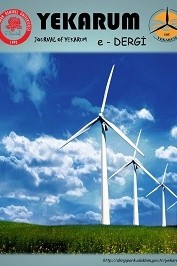Tekstil Endüstrisi Atık Suyunun Renk Giderimi İçin Elektrokoagülasyon Yöntemi Uygulaması
Bu çalışmada, tekstil endüstrisi atık suların renk giderimi konusunda yapılan çalışmalar ortaya konmuş ve tekstil sanayi atık suyunun Elektrokoagülasyon yöntemi kullanılarak arıtılabilirliliği incelenmiştir.
Bu amaçla mono polar paralel bağlı alüminyum elektrotları kullanarak, elektrokoagülasyon yönteminin performansı araştırılmıştır, elektrokoagülasyon yönteminde; renk giderim verimi üzerine çalışma yapılmıştır, yapılan deneysel çalışmalar sonucunda elde edilen veriler değerlendirilerek elektrokoagülasyon yönteminin olumlu sonuçları gözlemlenmiştir. Sonuç olarak, tekstil sanayi atık suyunun renk gideriminde elektrokoagülasyon yönteminin etkili bir yöntem olduğu ortaya konulmuştur.
Anahtar Kelimeler:
Tekstil Atık Suyu, Renk Giderimi, Elektrokoagülasyon Yöntemi
Application of Electrocoagulation Method for Decolorization of Textile Industry Wastewater
In this studies, conducted studies about decolorization of textile industry wastewater have been explained and treatability using the method of electrocoagulation of textile industry wastewater have been investigated. To this end, using monopolar parallel connected aluminum electrodes, performance of electrocoagulation method was investigated. In the method of electrocoagulation has been worked through on decolorization efficiency. Acquired data in result of experimental studies have been analysed and positive results of electrocoagulation have been observed. As a result, electrocoagulation method has been demonstrated to be an effective method in decolorization of textile industry wastewater.
Keywords:
Textile Waste Water, Color Removal, Electrocoagulation Method,
___
- ITKIB, İstanbul Tekstil ve Konfeksiyon İhracatçı Birlikleri, 2005. İhracat Raporu.
- GÖKNİL H., TORÖZ İ., ÇİMSİT Y., 1984. Endüstriyel atıksuların kontrol ve kısıtlama esasları projesi – Tekstil
- Endüstrisi. İTÜ Çevre ve Şehircilik Uygulama Araştırma Merkezi, İstanbul. TÜNAY O., 1996. Çevre
- Water Science and Technology, 22(9), 265 – 274. FERNANDES A., MORA A., MAGRINHO M., LOPES A. and GONÇALVES I., 2004. Electrochemical degradation of C. I. Acid Orange 7. Dyes and Pigments, 61, 287–296. SNOWDEN-SWAN L. J., 1995.
- Pollution prevention in textile industries, in industrial pollution prevention handbook, Eds. Freeman, H.M., McGraw- Hill, Inc., New York. BARRERA-DIAZ C., URENA- NUNEZ F., CAMPOS E., PALOMAR- PARDAVE M. and ROMERO-ROMO M., 2003. A combined electrochemical- irradiation treatment of highly colored and polluted industrial wastewater. Radiation
- Physics and Chemistry, 67, 657–663. LEGRINI O., OLIVEROS E. and BRAUN A.M., 1993. Photochemical processes for water treatment. Chemical Reviews, 93, 671 – 698.
- MOLLAH M. Y., MORKOVSKY P., GOMES J. A., KESMEZ M., PARGA J. R. and COCKE D. L., 2004. Fundamentals, present and future perspectives of electrocoagulation. Journal of Hazardous Materials, B114,199–210.
- DANESHVAR N., SORKHABI H. A. and KASIRI M.B., 200 Decolorization of dye solution containing Acid Red 14 by electrocoagulation with a comparative investigation of different electrode connections. Journal of Hazardous Materials, B112, 55–62. MOLLAH M. Y., SCHENNACH R., PARGA J. R. and COCKE D. L., 2001. Electrocoagulation (EC)-science and applications. Journal of Hazardous Materials, B84, 29 – 41.
- EPA, 1993. Electro-pure alternating current electrocoagulation. Emerging
- Technol. Summary, EPA-540/S-93/504, Washington. WOYTOWICH D. L., DALYMPLE C. W. and BRITTON M. G., 1993.
- Electrocoagulation (CURE) treatment of ship bilgewater for the US coast Guard in Alaska. J. Marine Technology Society, 27, 62 – 75. DELİPINAR Ş., 2007. Maya Endüstrisi Atıksularının Elektrokoagülasyon ve Kimyasal
- Koagülasyon ile Arıtımı, GYTE Müh. ve Fen Bil. Ens.,Yüksek Lisans Tezi, Gebze, 3
- Başlangıç: 2010
- Yayıncı: Süleyman Demirel Üniversitesi
